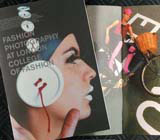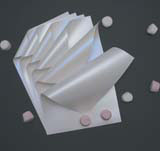Hard copy

Predicting trends in texture and colour is as crucial to paper-makers as fashion designers, but long lead times mean trend forecasting has to be accurate to be profitable. Lauretta Roberts finds out how the paper trade sorts the pulp from the classic styles
‘We’re seeing a re-emergence of texture, and metallics are continuing.’ It sounds like a soundbite from Vogue doesn’t it? It isn’t, but the similarity is not entirely coincidental. Keeping up with, and, indeed, predicting, fashion trends is as crucial to creative paper experts as it is to journalists on the glossies, as proven by Paula Parker, product and new product development manager at Arjo Wiggins.
Parker and her team frequently flick through fashion and interiors magazines to track texture and colour trends in fabric, furnishings and accessories, which inevitably translate into demand for certain paper stocks. Hence the French paper-maker – and, indeed, all creative paper-makers – needs to ensure its portfolio is appropriately stocked, to satisfy fashion-forward designers and paper-buyers.
It’s not just about being seen to be cool. As fashion retailers will tell you, having the right trends in stock at the right time is crucial. ‘Year on year, we’ve seen double-digit growth in the products that fit the fashion trends,’ says PaperCo’s Veronica Heaven. Currently, this means a move away from bright white smooth sheets to more natural, textured grades, she says.
But accommodating fashion trends is not as easy as it sounds. Unlike high street fashion retailers, which can translate a look from the catwalk and have it in-store in a matter of weeks, new paper products can take anything from six months to a year to bring to market. Therefore, paper designers need to assess emerging trends before they hit the catwalk. ‘Colour trends are predicted a long time before the general public sees anything on the high street,’ says Heaven.
Arjo Wiggins’s Parker is well aware of this, too. She and her team regularly attend the same trend fairs that are frequented by fashion designers. ‘We attend Première Vision, which is a trend fair for the fashion industry [in Paris]. As well as fabrics, it also has lots of accessories, such as zips, buttons, sequins and feathers,’ she explains, which are also investigated for ideas. To complement her team’s research, Arjo Wiggins also contracts the services of a Paris-based colourist – and isn’t the only paper-producer to do so.
Italian specialist paper producer Favini, for instance, employs a French colourist, which seeks inspiration for shades and texture through regular trips to countries with a rich colour culture, such as India, and through following other colour-led industries like automobiles and plastics. Favini’s Chameleon product, which forms part of its Majestic range, changes colour when viewed from different angles and was inspired by the finish on a car. Arjo Wiggins, too, was influenced by the trend for iridescent paint on cars for its Curious Collection.
Once a trend is predicted by a colourist, the next stage is, typically, to create a mood board, which is taken to R&D teams at paper mills for translation into a product. Feasibility studies follow and, if it’s feasible and deemed sensible, a product will be added to a range or a new range is created. Favini says it currently has six new patterns in testing, which are very directly influenced by fabric fashion and which should be added to its Twill range of felt-marked papers by the end of the year.

Given that it can be a lengthy and expensive process to bring a brand new grade to market, paper-makers need to be sure that any trend they follow is more than just a short-lived fad, though more ephemeral trends can be satisfied with special edition colours in existing paper ranges. ‘Our Keay Kolour range is quite corporate,’ says Parker, ‘but there will always be a need for a navy blue and a nice red, and then you can always add a fashion colour to spice things up.’
If all else fails and you can’t find exactly what you want, you could opt for a bespoke paper-making service. For instance, Dutchman Plus – available from paper merchant Elliott Baxter – is a new natural shade addition to the popular Dutchman range of high bright papers, and therefore taps into the trend for softer shades, but it can be made to match ‘any shade or tint’. Like all things tailor-made, such a service is likely to cost more, but there are some appealing off-the-shelf options, designed to emulate popular cloths.
Italian paper-maker Fedrigoni holds a range called Savile Row, that features plain, pinstripe and tweed cloth-like options. But one of the most complete ranges of fashion and fabric-inspired stocks comes from German producer Gmund. Its Alezan grade is claimed to be the world’s first paper to look and feel like leather; its Kashmir mimics the finest wool; while the Tatjana range (named after an imaginary 1920s couturier) features individual shades named after ‘precious fabric and cloth’, such as Organza, Brocade and Chiffon. All of these grades are standard stock and are always available, whatever the fashion. In paper, just as in clothing, the classics prevail.
Lauretta Roberts is editor of PrintWeek
-
Post a comment



